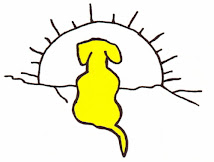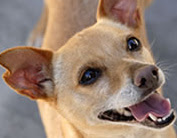Venture to any off-leash dog arena and these are the types of behaviors you’ll likely see being displayed: 
 When dogs aren't exhibiting healthy dog play behaviors, there are several things you, as a responsibly aware dog guardian can do.
When dogs aren't exhibiting healthy dog play behaviors, there are several things you, as a responsibly aware dog guardian can do.

- dogs chasing after other dogs
- dogs being chased
- mouthing
- nipping
- tugging
- chest banging
- pinning
- wrestling
- rolling
- mounting
- Big, inefficient movements amongst all involved. Think “Three Stooges” versus Muhammad Ali.
- Self-interruption: One dog will stop for a second or two to take a break, others follow by taking a break as well.
- Good “listening” skills: If one dog no longer wants to play, they will communicate as such, and the other dog will comply and go in search of another playmate.
 When dogs aren't exhibiting healthy dog play behaviors, there are several things you, as a responsibly aware dog guardian can do.
When dogs aren't exhibiting healthy dog play behaviors, there are several things you, as a responsibly aware dog guardian can do. The goal: to help your dog build trust and self-confidence. You can easily do this by rewarding your dog for being brave. EX: your dog looks at, approaches gently, or investigates another dog, he or she gets a yummy food reward, and lots of "cheerleading happy talk". You can also reward with food and praise if another dog approaches your dog to say *hi*. This is similar to encouraging young children to make new friends. As humans we use encouraging verbal language and praise to help children deal with shyness and novel experiences. We can do the same for our pet dogs too. Through food, your dog learns to trust, while making positive associations with other dogs they meet.
Additional techniques that may come in handy…
Additional techniques that may come in handy…
- Manage your environment or “avoid” if necessary: This is for when you don’t have the right kind of rewards handy, you don’t have the time to train, or you just don’t feel like dealing with the situation.
- Come up with your best “spin”: “I’m so sorry, I’m running late today and don’t have time to stop. How about another time?” “Oh geez, wouldn’t you know it, I’ve only got a couple of minutes to get my dog exercise, so I’m gonna have to take a rain check. Thanks though!”
- And with the convenience of modern gadgets, you can always be tied up on the phone, or even pretend to be on the phone - just make sure the ringers off so you don’t get a call while you’re faking it. I know, it’s a white lie, not very ethical. But hey, you’re doing it to protect your family and your sanity!
- In the case with "Austin", maintain a friendly relationship between you and your neighbor: You can use some of the same techniques with your neighbor’s dog too. Bring a basket of muffins for your neighbor, and treats for both dogs. You can reward the Pom for being nice towards your dog, while continuing the treat plan with your Cocker. If the Pom begins to “act up” the rewards stop, and you suddenly remember you have to leave. You can also explain to your neighbor that you’re trying to help your dog overcome her shyness. Many people love to help and feel needed, so it’s a good time to fill her in on your plan and ask for assistance.
- Dog training classes and doggy socials: even for dogs that are already trained, getting into classes helps build up or maintain trained skills, but also helps to keep dogs socialized. Sometimes classes are the only time dogs get to be around other dogs.

 Humans commonly assume that dogs that "hump" or "mount" just want to have sex with them, or that the dog is attracted to them etc... Ugh... really? Do you really think you're that charming, and that maybe all of the spoiling has lead your dog to want to return the favor in a way they think you might like? Come on... here's a quickie lesson on dogs humping and dog play:
Humans commonly assume that dogs that "hump" or "mount" just want to have sex with them, or that the dog is attracted to them etc... Ugh... really? Do you really think you're that charming, and that maybe all of the spoiling has lead your dog to want to return the favor in a way they think you might like? Come on... here's a quickie lesson on dogs humping and dog play:
 *A BIG note of importance:
*A BIG note of importance: 

